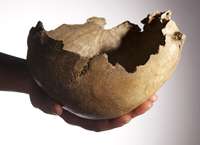One of the human skull-cups made by ice age Britons 14,700 years ago unearthed from Gough's Cave. The process required great skill and knowledge of anatomy.
Ice age Britons drank from human skulls and may even have eaten flesh and bone marrow, but they were far from barbarians.
That's the conclusion of experts studying the oldest known examples of "skull cups," found in a cave in southwest England.
The bowls look almost like works of art, ritual items laced with meaning. Look more closely, however, and it becomes clear they are made from human skulls. Scientists say they are the oldest known carbon-dated skull cups, said by experts to be about 14,700 years old.
British scientists writing in the Public Library of Science journal maintain the cups were fashioned in such a meticulous way that they only credible explanation for their manufacture is that they were used as bowls to hold liquid. If the hunters and gatherers simply wanted to eat the deceased person's brains, there would have been far easier ways to get at them, scientists said.
Experts believe the rare cups - two made from adults skulls, one from a child thought to be about three years-old - were used in some sort of ritual, as was common in many parts of the world.
"It is likely that this was part of some symbolic ritual and not mere necessity," said Sylvia Bello, lead author of the study. She said that the artifacts demonstrate how skilled early humans were at the manipulation of human bodies.
The practice of using human skulls as cups or bowls has been well documented in many cultures, and in some cases skull cups have been elaborately decorated and used to adorn temples and in religious ceremonies. The practice was documented by the Greek historian Herodotus in the fifth century B.C..
But the three skull cups found in an English cave are the only known examples from the British Isles, scientists said.
The three skulls aren't the first historic clues to early man found in Gough's Cave in Somerset. In 1903, the complete skeleton of a man dated to about 10,000 years ago was found at the same site. Explorations of the site, which in human and animal remains, began even earlier.
Although the team found indications that some of the flesh and bone marrow from the skulls was eaten, they concluded that cannibalism was unlikely to have been the main purpose of the modifications.
"It is impossible to say the flesh was consumed," Bello said. "They could have de-fleshed to have a clean skull to work with, but then did they consume part of the brain or the soft tissue? We can't prove it. I don't know if they then consumed the brain, but that wasn't the first purpose."
She did say the bone marrow seems to have been consumed.
The use of skulls as cups or bowls in northern Europe is thought to have been fairly common during that time frame, but it is very rare to find actual examples that can be accurately dated by modern techniques, said Rick Schulting, an archaeology professor at the University of Oxford.
"These finds are important because there are so few finds from this period," he said. "These are fully modern humans like us but we have very little insight into what they thought about themselves and their world. We know they had some burials, we know they cared about their dead. This adds complexity to their world."
He said they were probably used in the ritual consumption of human remains, but said details cannot be known.
"It's not some barbaric bloodthirsty example," said Schulting, who was not involved in the project. "It's always a ritualistic setting where you eat the remains of the dead, but we can't know in this case whether you're eating your own revered ancestors, to keep in contact, or eating the outsider, the enemy, as a way of insulting them and imbibing their power and their spirit."
He said it was not unusual in that time period for people to consume the brain, which is seen as the seat of an individual's identity, but it is not clear because of the lack of evidence whether this was done as an act of respect or contempt.
The distribution of cut marks seen on the skulls indicates that they were scrupulously "cleaned" of any soft tissues, and subsequently modified by the removal of the facial region. The skulls were then meticulously shaped into cups by retouching the broken edges, Bello said.
"All in all it was a very painstaking process given the tools available," she said.
©2010 The Associated Press. All rights reserved. This material may not be published, broadcast, rewritten or redistributed.






















